Family: Tenthredinidae
Family common name: common sawflies
Subfamily: Selandriinae
Tribe: Aneugmenini
Genus: Nesoselandria Rohwer, 1910
Subgenera: none
The Tenthredinidae are the most species-rich family and are found throughout the world, in all continents but Antarctica. They are known as the “common sawflies.” They can generally be recognized by a cylindrical body and long, segmented antennaeantenna:
the sensory organ emerging from the front of the head, usually between the compound eyes and above the clypeus; includes the flagellum, scape and pedicel
 . Otherwise, they come in a variety of colors, sizes, and forms (Goulet 1992Goulet 1992:
. Otherwise, they come in a variety of colors, sizes, and forms (Goulet 1992Goulet 1992:
Goulet H. 1992. The genera and subgenera of the sawflies of Canada and Alaska: Hymenoptera. Symphyta. The insects and arachnids of Canada. Part 20. Agriculture Canada Publication.).
Sawflies in the Selandriinae subfamily are relatively small and slender. The range of Selandriinae is worldwide; it occurs on all continents except Antarctica (Goulet 1992Goulet 1992:
Goulet H. 1992. The genera and subgenera of the sawflies of Canada and Alaska: Hymenoptera. Symphyta. The insects and arachnids of Canada. Part 20. Agriculture Canada Publication.). It is the most common and diverse group of tenthredinids in tropical regions, particularly in Central America, South America, and Southeast Asia (Smith 1969eSmith 1969e:
Smith DR. 1969e. Nearctic Sawflies. II. Selandriinae: Adults (Hymenoptera: Tenthredinidae). Technical Bulletin, U.S. Department of Agriculture 1398: 1-48.). Selandriinae contains the only known sawflies that feed on non-vascular plants, specifically ferns (Smith et al. 2013Smith et al. 2013:
Smith DR, Janzen DH and Hallwachs W. 2013. Food plants and life histories of sawflies of the families Argidae and Tenthredinidae (Hymenoptera) in Costa Rica, a supplement. Journal of Hymenoptera Research 35: 17-31. https://doi.org/10.3897/JHR.35.5496). The subfamily can be distinguished from other subfamilies by wing venationvenation:
the network of veins on a wing
(Goulet 1992Goulet 1992:
Goulet H. 1992. The genera and subgenera of the sawflies of Canada and Alaska: Hymenoptera. Symphyta. The insects and arachnids of Canada. Part 20. Agriculture Canada Publication.).
Nesoselandria is monotypicmonotypic:
describes having only one representative; ex. a genus that includes only one species
in the NearcticNearctic:
describing the region of the Northern Hemisphere that includes North America south through northern Mexico
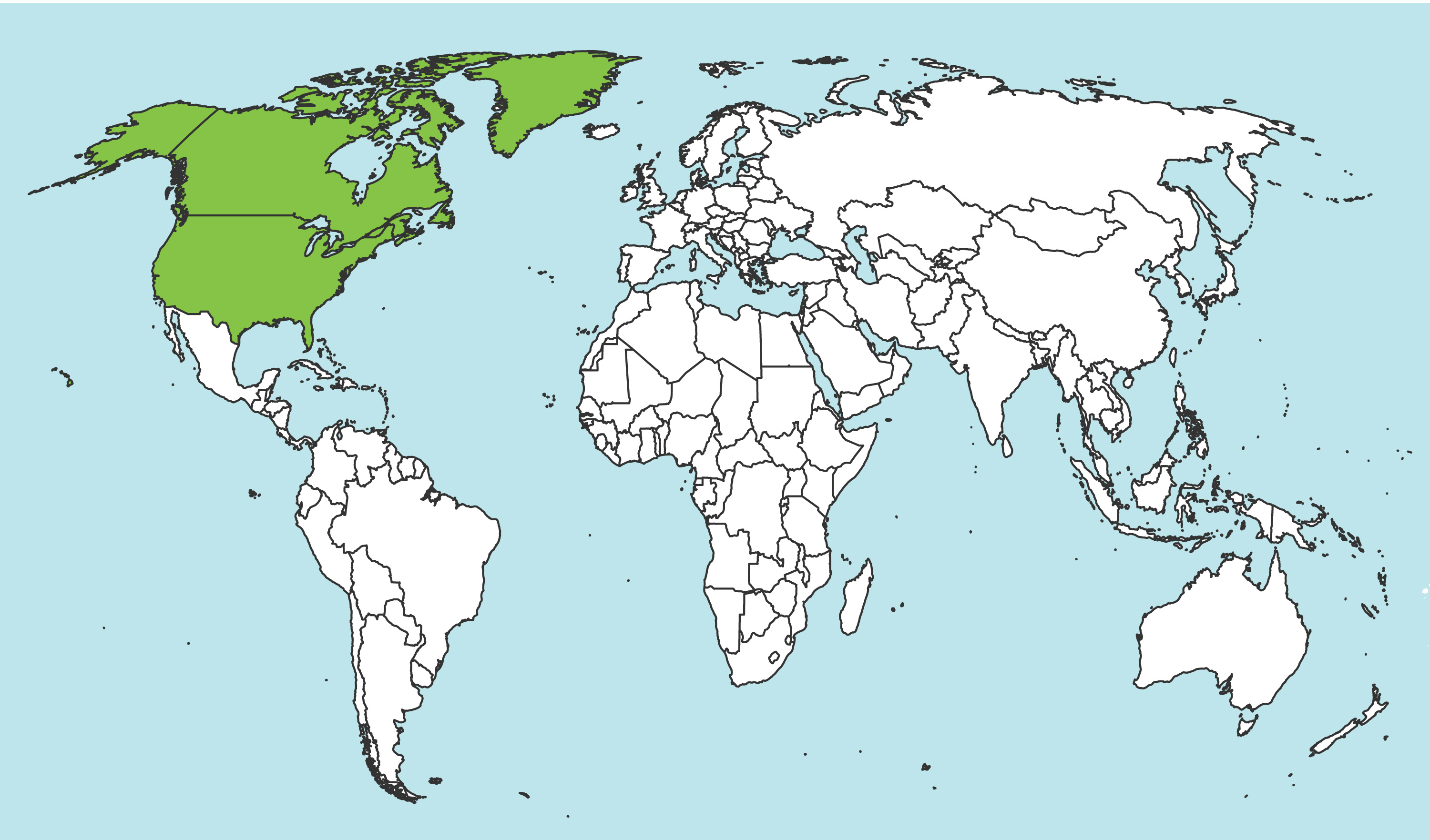 region. Nesoselandria morio are small and stout, about 4.5 mm in length, and mostly black with orange legs and darkened wings (Smith 1969eSmith 1969e:
region. Nesoselandria morio are small and stout, about 4.5 mm in length, and mostly black with orange legs and darkened wings (Smith 1969eSmith 1969e:
Smith DR. 1969e. Nearctic Sawflies. II. Selandriinae: Adults (Hymenoptera: Tenthredinidae). Technical Bulletin, U.S. Department of Agriculture 1398: 1-48.). Though many sawfly hosts are unknown, Nesoselandria is the only genus known to feed on mosses (Vikberg and Nuorteva 1997Vikberg and Nuorteva 1997:
Vikberg V and Nuorteva M. 1997. On the rearing of Nesoselandria morio (Fabricius) and Birka cinereipes (Klug) (Hymenoptera, Tenthredinidae), with descriptions of their larvae. Entomologica Fennica 8: 27-38.).
There are 81 described extantextant:
in existence; opposite of extinct
species worldwide. Three species occur in North America, only one north of Mexico (Taeger et al. 2010Taeger et al. 2010:
Taeger A, Blank SM, and Liston AD. 2010. World Catalog of Symphyta (Hymenoptera). Zootaxa 2580: 1-1064.).
Subfamily characters
 vein Rs+M curved near intersection with veinvein:
vein Rs+M curved near intersection with veinvein: Sc+R (Smith 1969eSmith 1969e:
Sc+R (Smith 1969eSmith 1969e: veins M and m-cu about parallel (Smith 1969eSmith 1969e:
veins M and m-cu about parallel (Smith 1969eSmith 1969e: vein 2r-m present (Goulet 1992Goulet 1992:
vein 2r-m present (Goulet 1992Goulet 1992:Genus characters
 margin straight or shallowly emarginated (Smith 1969eSmith 1969e:
margin straight or shallowly emarginated (Smith 1969eSmith 1969e: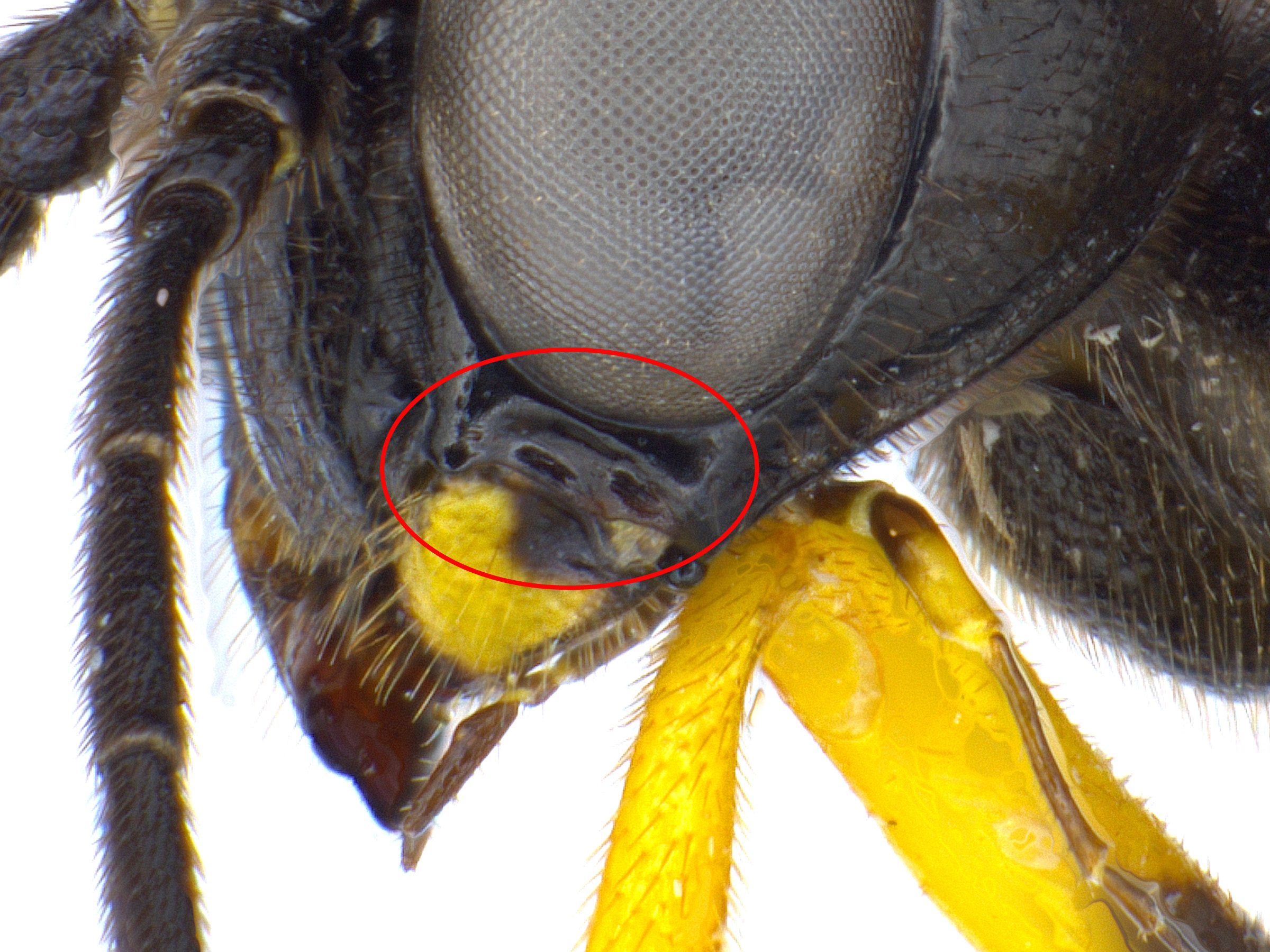 length about half the diameter of front ocellusocellus:
length about half the diameter of front ocellusocellus: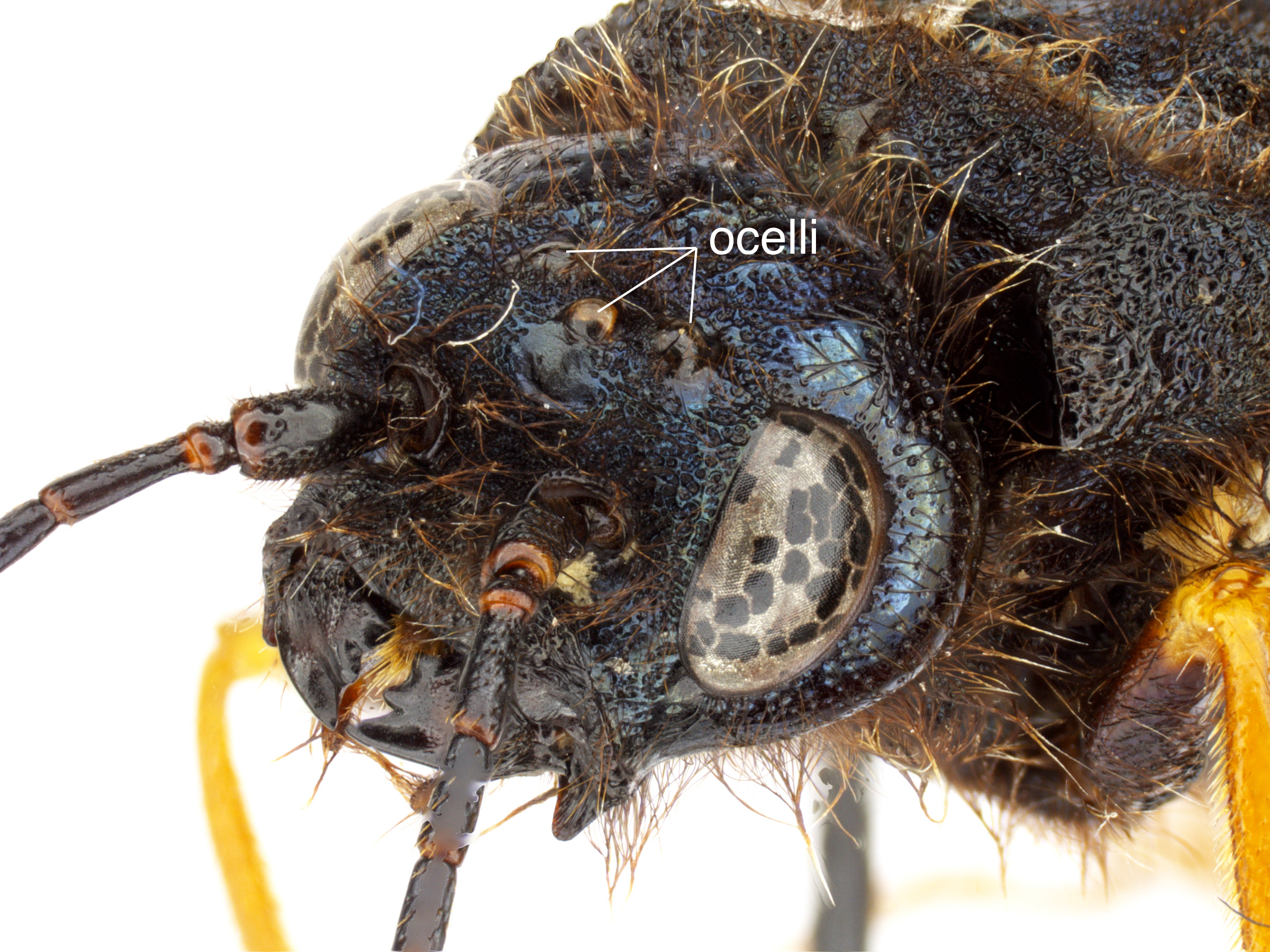 (Smith 1969eSmith 1969e:
(Smith 1969eSmith 1969e: longer than wide (Smith 1969eSmith 1969e:
longer than wide (Smith 1969eSmith 1969e: vein M meeting Sc+R at intersection of Rs+M and Sc+R (Smith 1969eSmith 1969e:
vein M meeting Sc+R at intersection of Rs+M and Sc+R (Smith 1969eSmith 1969e: anal crossveinanal crossvein:
anal crossveinanal crossvein: anal cellanal cell:
anal cellanal cell: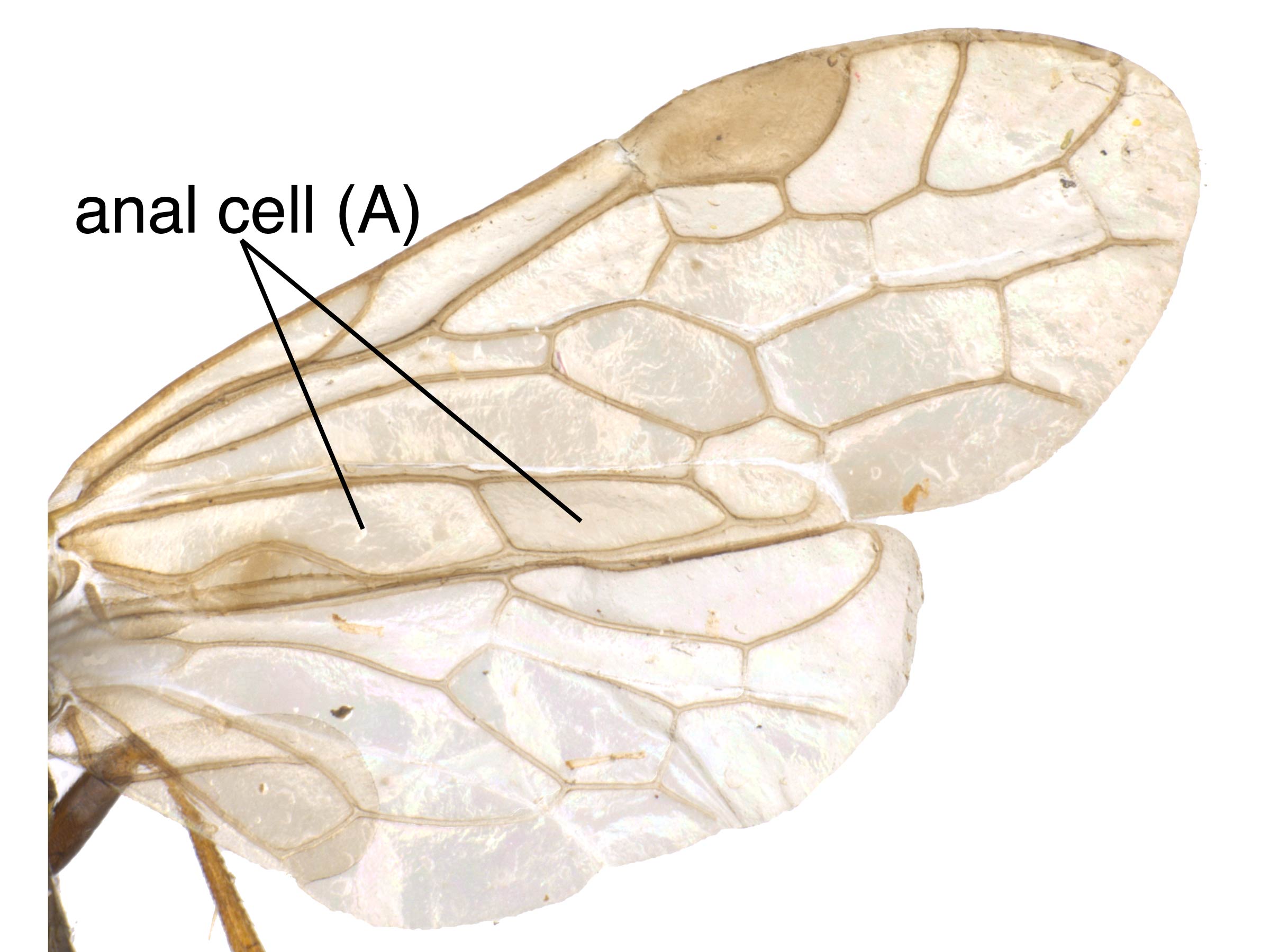 petiole short (Goulet 1992Goulet 1992:
petiole short (Goulet 1992Goulet 1992: with relatively long inner tooth (Smith 1969eSmith 1969e:
with relatively long inner tooth (Smith 1969eSmith 1969e:Nesoselandria can be confused with similar species in the subfamily Selandriinae or tribe Aneugmenini. It can be distinguished from most other genera by the absence of a fore wingfore wing:
the anterior wing of each pair of wings; usually the largest wing of the pair
 anal crossveinanal crossvein:
anal crossveinanal crossvein:
a crossvein that goes through the center of the basal anal cell
, from closely related Aneugmenus by the lack of an occipitalocciput:
the posterior surface of the head
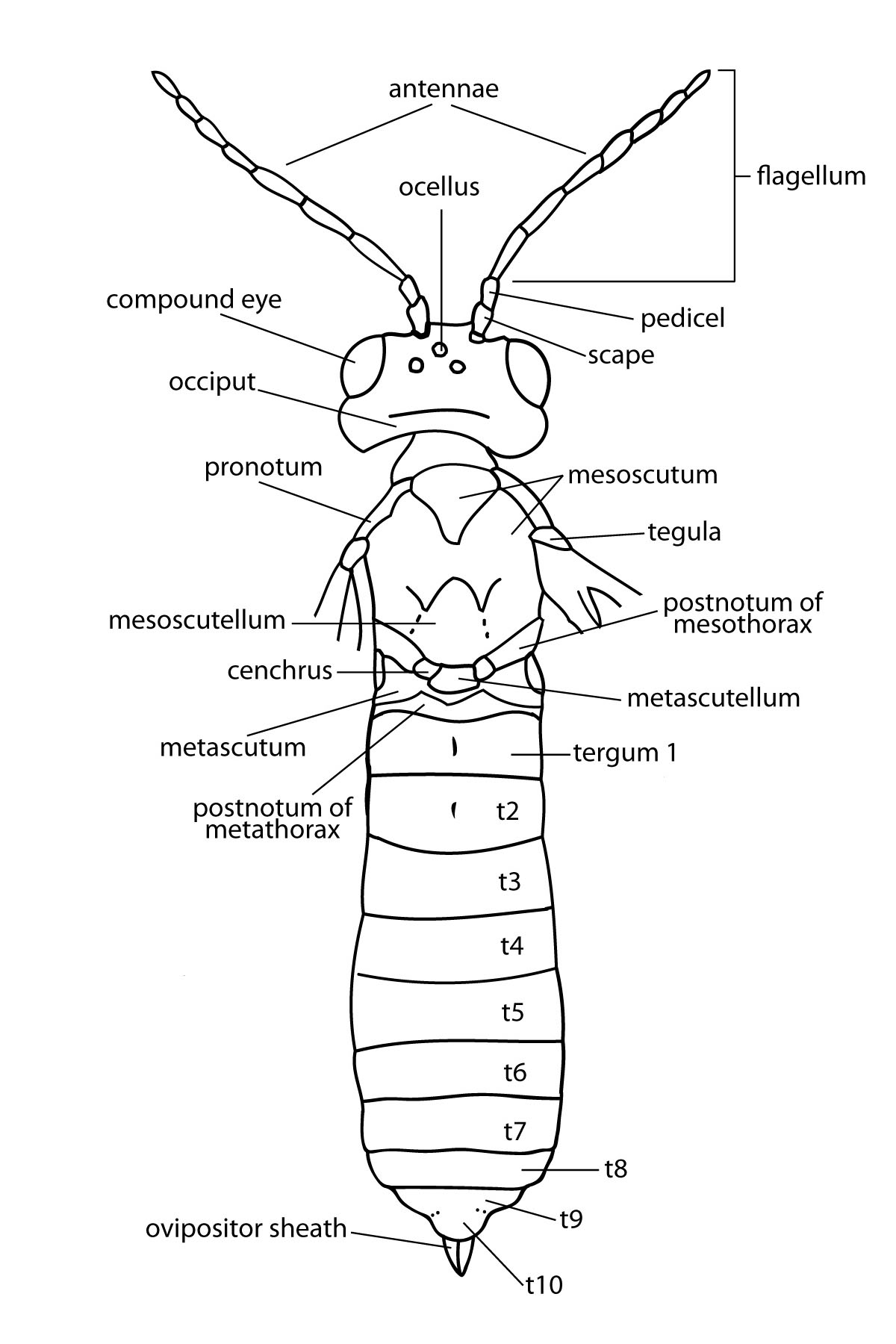 ridge, and from Birka by the malar spacemalar space:
ridge, and from Birka by the malar spacemalar space:
the minimum distance between the base of the mandible and the ventral margin of the compound eye
 length (Smith 1969eSmith 1969e:
length (Smith 1969eSmith 1969e:
Smith DR. 1969e. Nearctic Sawflies. II. Selandriinae: Adults (Hymenoptera: Tenthredinidae). Technical Bulletin, U.S. Department of Agriculture 1398: 1-48.).
none
Hosts for N. morio in North America are not known. In Europe, N. morio feeds on mosses in the class Bryopsida, including Ceratodon purpureus (purple moss), Plagiomnium cuspidatum (baby tooth moss), Hedwigia ciliata (white-tipped moss), Plagiothecium denticulatum (toothed plagiothecium moss), and Polytrichum commune (common haircap moss) (Vikberg and Nuorteva 1997Vikberg and Nuorteva 1997:
Vikberg V and Nuorteva M. 1997. On the rearing of Nesoselandria morio (Fabricius) and Birka cinereipes (Klug) (Hymenoptera, Tenthredinidae), with descriptions of their larvae. Entomologica Fennica 8: 27-38.).
Female N. morio deposit eggs on the leaves. LarvaeLarva:
the immature stage of holometabolous insects
 are gray and shiny with light brown head capsules. At maturity, prepupae fall to the ground and make sand cocoons. In experiments, N. morio pupated in less than two months, implying multiple generations per year (Vikberg and Nuorteva 1997Vikberg and Nuorteva 1997:
are gray and shiny with light brown head capsules. At maturity, prepupae fall to the ground and make sand cocoons. In experiments, N. morio pupated in less than two months, implying multiple generations per year (Vikberg and Nuorteva 1997Vikberg and Nuorteva 1997:
Vikberg V and Nuorteva M. 1997. On the rearing of Nesoselandria morio (Fabricius) and Birka cinereipes (Klug) (Hymenoptera, Tenthredinidae), with descriptions of their larvae. Entomologica Fennica 8: 27-38.).
Nesoselandria morio was first discovered in North America in British Columbia, Ontario, and Quebec in 1967. Because this species historically is known from both Europe and Japan, it is not clear from where or how the species was introduced (Smith 1967bSmith 1967b:
Smith DR. 1967b. A review of the larvae of Xyelidae, with notes on the family classification (Hymenoptera). Annals of the Entomological Society of America 60 (2): 376-384.). Only females are known in North America (Smith 1969eSmith 1969e:
Smith DR. 1969e. Nearctic Sawflies. II. Selandriinae: Adults (Hymenoptera: Tenthredinidae). Technical Bulletin, U.S. Department of Agriculture 1398: 1-48.).
World: This genus is known from North America as well as South, Southeast, and East Asia (Saini et al. 2001Saini et al. 2001:
Saini MS, Saini TP, and Vasu V. 2001. Revision of the genus Nesoselandria Rohwer from India (Hymenoptera: Symphyta: Tenthredinidae: Selandriinae) with description of six new species. Zoosrsquo; Print Journal 16 (11): 615-628., Taeger et al. 2010Taeger et al. 2010:
Taeger A, Blank SM, and Liston AD. 2010. World Catalog of Symphyta (Hymenoptera). Zootaxa 2580: 1-1064.).
North America: Nesoselandria morio is established in New Hampshire, Quebec, and Ontario in the east and British Columbia in the west (Smith 1969eSmith 1969e:
Smith DR. 1969e. Nearctic Sawflies. II. Selandriinae: Adults (Hymenoptera: Tenthredinidae). Technical Bulletin, U.S. Department of Agriculture 1398: 1-48.). South of the United States, N. crassa is known from Panama and N. rufonota is known from Acapulco, Mexico (Rohwer 1911Rohwer 1911:
Rohwer SA. 1911. New sawflies in the collections of the United States National Museum. Proceedings of the United States National Museum 41: 377-411., Rohwer 1912Rohwer 1912:
Rohwer SA. 1912. Sawflies from Panama, with descriptions of new genera and species. Smithsonian Miscellaneous Collections 59 (12): 1-6.).
Map data from: GBIF.org (29 October 2019) GBIF Occurrence Download Nesoselandria
Details about data used for maps can be found here.